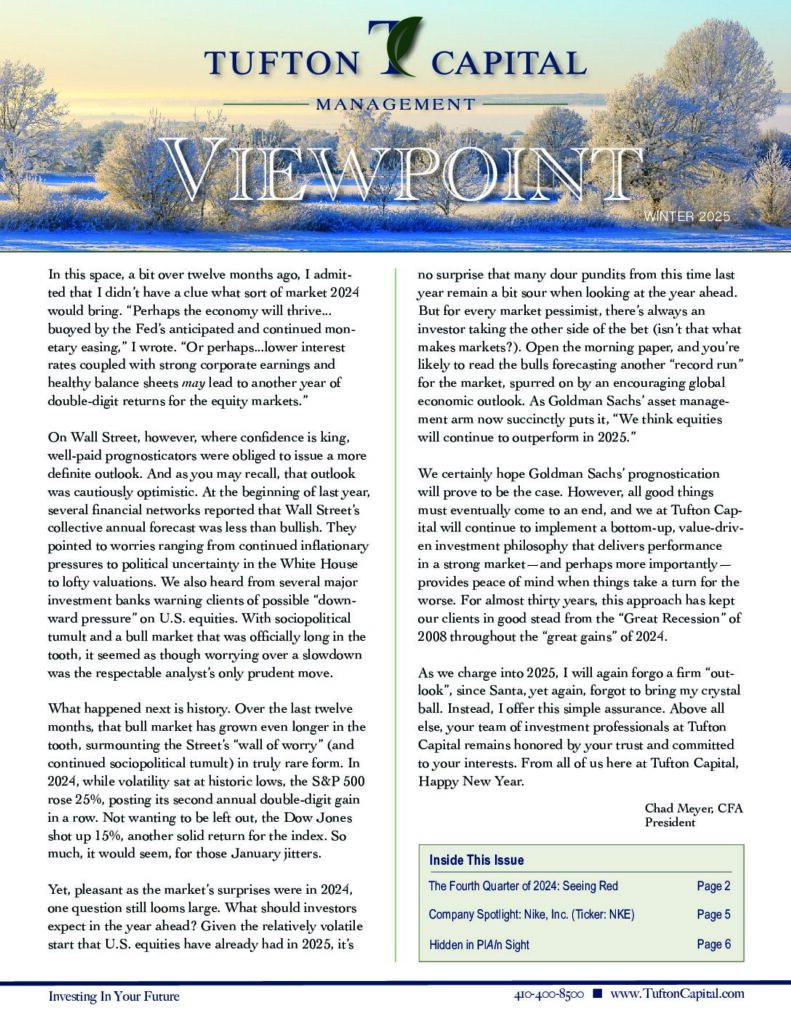The first week of February was a rollercoaster. For the week, the Dow ended down .55%, the S&P .72%, and the NASDAQ .28%. These numbers do not tell the story, however, of a week that saw the Dow get down to 9835.
Among other woes, continuing concern over the debt obligations of Greece, Spain, and Portugal weighed on the markets. The countries appear to be in a position where they may default on debt owed to other countries. While it is not likely to be an astronomical amount of money, the issue is concerning to an already-stressed Europe.
A good jobs report Friday can be credited with keeping the Dow over 10,000. Unfortunately, it did not prevent the markets from falling as far as they did.
We had another disappointment in the markets this week. The Dow ended the week down 5.11%, the S&P 5.46%, and the NASDAQ 6.15%. Especially beaten were tech stocks, underscored by Apple suffering from those who “sold the news” of the new tablet, as well as some general pessimism about the tablet’s ability to be truly “revolutionary.”
We’re on the record saying we won’t have a double-dip recession though, and we still believe that. GDP numbers released this morning were strong- the Commerce Department reported that the economy grew at an annual rate of 5.7% during the fourth quarter of last year. While bad news continues to abound, it all comes down to the product of our economy, that is, the GDP. We saw today’s report as the promise of a continued recovery.
Next week will be all about jobs. While there will be some data released on manufacturing, the main focus will be on the unemployment rate. We will be looking to this number to tell us where we are on the road to recovery.
This week saw the year-to-date gains lost in just a few days’ trading. Selling pressure came from two directions: first, an already-nervous market was primed to sell on earnings news. Second, the political rhetoric on healthcare and banking reform spooked many investors. The week ended with the Dow down 4.19%, the S&P down 4.65%, and the NASDAQ down 4.83%.
There has been concern that this is the beginning of the long-feared correction. However, we believe the drop is short-term in nature, and depending on the severity, could present a good buying opportunity.
This idea of reform should not concern the market. Rep. Barney Frank said that he would not let the banking reforms pass as described. If any proposed bill does fail, it should assuage the fears of investors and help these losses be recovered.
Next week is a heavy earnings week, which we will be watching closely. It is a light week for economic data. While we will certainly be in tune to fresh data in housing and employment, the standout figure is the fourth quarter’s GDP number.
The markets had a down week, after a disappointing slide Friday. The Dow ended mostly flat, finishing up the week -.08%. The S&P and NASDAQ were down .78% and 1.26%, respectively. Leading the decline were financial stocks, after a disappointing report from J.P. Morgan that rekindled fears of large loan losses. More banks report next week, and will hopefully bring brighter news.
This week, $74 million left domestic equities, while $2.7 billion entered foreign equities. Investors continue to put money into ETFs- a relatively new strategy that is not captured in the above equity numbers. The patterns of investing may have changed- but we believe that the “general consensus” will continue to tell us how to do what’s right- by doing what’s wrong.
The markets had a good week overall, starting the first week of the new year on a high note. The S&P was up 2.68%, the NASDAQ 2.12%, and the Dow 1.82%. Mostly driving the gains were positive economic data. The feared “correction” in the first part of the new year has yet to transpire. Bonds took a breather from the beating they were taking. Yields stabilized after four weeks of advancing.
Next week is a big one for data, bringing key readings that are critical to the recovery. We will see numbers on industrial production, retail sales, inflation, and housing.
After a very dreary quarter, markets managed to recover substantially in 2009, for an impressive 26.5% return. The year started out very grim, with the S&P dropping 10.9%, on top of the 37% it lost the previous year. Overall, the index saw a peak-to-trough decline of 55.2% on a total return basis. From that trough on March 9, the S&P gained 67.8% as of December 31.
Treasuries dipped to levels some may have thought impossible, and certainly almost all saw as absurd. Short-term Treasury yields dipped below zero for a brief time, actually offering negative returns. Such was the fear at the bottom— people would accept a negative return just for the perceived safety of a treasury.
As the economy recovers, one of the most closely followed indicators will be an improving unemployment rate. We look towards weekly initial claims to gauge the health of employment. Now, we look for total claims to continue to fall— for those without a job, it is the only economic statistic that really matters.
For 2010, we expect equities to appreciate by 10-18%. Bonds, on the other hand, should provide negative returns for the year.
For more, look for the forthcoming Hardesty Horizons newsletter for 4Q 2009.
 The 4th quarter was another good one for the stock market, marking its third consecutive advance. As a leading indicator for the economy, the market is signaling investors the recovery is real. Where there are still plenty of skeptics, it would appear to us the improving economic data is forming a base upon which a meaningful, sustainable economic recovery can occur.
The 4th quarter was another good one for the stock market, marking its third consecutive advance. As a leading indicator for the economy, the market is signaling investors the recovery is real. Where there are still plenty of skeptics, it would appear to us the improving economic data is forming a base upon which a meaningful, sustainable economic recovery can occur.
For the quarter, the S&P 500 returned 6.01%. You may recall the 2nd and 3rd quarters returned 15.94% and 15.56%, respectively. From the index’s trough on March 9, 2009, the S&P 500 has returned 67.8%, one of the strongest nine-month periods in the history of the index. The Dow Jones Industrial Average returned 59.8% over the same time period. For the full year 2009, the S&P 500, Dow and Nasdaq returned 26.50%, 22.60% and 43.91%, respectively. After an abysmal 2008, these results were well-received.
As the stock market began its recovery, the bond market moved in the opposite direction. In the first half of 2009, we saw interest rates move to historic lows as the government continued to work to grease the skids of the credit markets. As these programs began to have a positive effect, interest rates began moving higher. By the end of the year, those rates were much higher. The 10-year Treasury started 2009 yielding 2.20% and ended it yielding 3.79%. As you will recall, when yields rise, bond prices fall. Most Treasuries provided investors with a negative return for the year. Because of the perceived risks in Corporate and Municipal bonds during the year, their yields did not drop as much. The result for investors was that bonds produced positive returns for the year. The Barclays Corporate Index returned 5.24% for the year and the Barclay’s Municipal Index returned 7.61%. (more…)
 Our 4th quarter letter always presents a bit of a conundrum—it’s the end-of-year issue, yet typically being written as the New Year commences. And that brain-teaser is further amplified by this, our 2009 edition… is it the end of the decade, or do we have another year to go? Here’s one vote for it being the end of the 00’s decade, which certainly lived up to its moniker when viewed through the prism of investment results.
Our 4th quarter letter always presents a bit of a conundrum—it’s the end-of-year issue, yet typically being written as the New Year commences. And that brain-teaser is further amplified by this, our 2009 edition… is it the end of the decade, or do we have another year to go? Here’s one vote for it being the end of the 00’s decade, which certainly lived up to its moniker when viewed through the prism of investment results.
The writer was reminded of an earlier piece, penned back in the 2nd quarter of 2006, at which time there were indications that the “00’s were shaping up to be the worst decade since the 30’s,” according to Ed Hyman of International Strategy & Investment. Well, with the results almost in by December 20, 2009, Tom Lauricella of WSJ.com felt confident enough to lead with this sub-header: “Since End of 1999, U.S. Stocks’ Performance Has Been the All-Time Clunker; Even 1930s Beat It.” Lauricella further notes that, “Many financial plans assume a 10% annual return for stocks over the long term, but over the last 20 years, the S&P 500 is registering 8.2%.” (more…)
Markets were mostly flat this week, but were pummeled on Thursday due to employment data. For the week, the Dow lost 1.36%, and the S&P .36%. The NASDAQ actually rallied Friday, ending the week up .98%. Initial jobless claims unexpectedly rose on Thursday by 7,000 from the week prior, for a total of 480,000. While still below the 500,000 level, the unexpected increase signals that there is still far to go on the road to recovery.
Bond data released this week painted an interesting picture of the market. Near record amounts of non-investment grade bonds have been sold this year. The record was set in 2006, with $143.5 billion sold. This year, $142.8 billion have been sold. These compare to last year, with only $48 billion of these bonds being sold. The new figures tell us that the appetite for risk is back in bonds. Once again, investors are reaching for extra yield, and taking more risk to do so. It is frightening to think that investors have already forgotten the lessons to be learned in the near-collapse last year.
Next week, we continue to looks for signs of recovery. We will get readings on the housing market, employment, and consumer confidence.
Stocks had a mixed week, with the Dow up .8%, the S&P up .04%, and the NASDAQ down .18%. Initial jobless claims were unexpectedly higher this week, but this fact was balanced somewhat by the report that the trade gap had narrowed. The resultant conclusion was that while employment may not be rocketing back, the economy does seem to have regained some footing.
Banks continue not to loan out money. Our estimation is that they are scared to do so because of the new perceptions of risk. The banks are angry in their position- they don’t seem to be renewing lines of credit held by businesses.
The markets seemed unsure of themselves this week— big gains on Tuesday, a drop in late trading Thursday, and big swings in both directions Friday. The very positive jobs report Friday prompted some early gains— only to be reversed later in the day. When all was said and done, the Dow was up .77% for the week, the S&P 1.32%, and the NASDAQ 2.6%.
Looking forward to the holiday gift-buying season, there is some concern that inventories are too low, which will result in lower sales levels than what may be demanded. This shortage of supply would, however, enable retailers to earn higher margins on the inventory they do have- there would be no need for product markdowns.
Next week is a relatively light week for economic data. At the end of the week, we will be watching continuing claims for unemployment, retail sales, and consumer confidence. Check back soon for our 2010 market outlook.
The markets had a mixed week, and an especially unnerving drop on Thursday. The Dow was up .46%, the S&P down .19%, and the NASDAQ down 1.01%. Markets were shaken Thursday, with a 94-point drop in the Dow. On Thursday evening, Dell reported earnings numbers, which were much lower than expected. Dell has had difficulty maintaining their margins while offering discounts to encourage sales during the recession.
There is some contention about the level of sales we will see in the coming Black Friday and general Christmas selling season. On one hand, retailers are offering deep discounts, which may simply be a reflection of high markups, but the important result is the consumer’s perception of value. On the other, retail inventories were down 14% for the month of October, according to the Census Bureau data released November 16. This figure might indicate that retailers are expecting a relatively light Christmas season.
Next week, there is a significant amount of housing data being released. Both new and existing home sales will be coming out, as well as mortgage applications and the home price index. We will also see durable goods orders, consumer confidence figures, and of course, weekly initial jobless claims.
Markets had another strong week, with the Dow up 2.5%, the S%P 2.3%, and the NASDAQ 2.6%. Earnings reports continued to be strong, with Ebay, Carefusion, and Norfolk Southern all posting impressive numbers. Consumer sentiment fell in early November, according to a preliminary report released Friday. Mounting unemployment may be to blame, as consumers do not view the recovery as imminent as bullish economists.
We are somewhat disappointed by the status of the TARP stimulus money. Particularly, banks took their stimulus money and did not loan it out, preferring instead to shore up their own capital. We see an abundance of new loans in China, where steel output has reached 660 million tons compared to the U.S.’ 50.7 million tons. China is clearly using their stimulus money for infrastructure development. The loans were made by banks in China not because of an appetite for risk; rather, the government “encouraged” them to make funds available. While the result is good- significant rebound in manufacturing- we do not advocate any move towards a command economy. The excess reserves in U.S. banks may not have provided the same jumpstart as China’s loans, but they stand ready to be lent against to support the system in a recovery.
Next week, inflation is big, with both the CPI and PPI being reported. Also released will be retail sales and housing starts. Hopefully, the latter two will paint a brighter picture of the recovery, and will help turn some consumers around.
This week, the markets seesawed back up, with the Dow gaining 2.56%, the S&P 2.29%, and the NASDAQ 2.68%. The Dow continued teasing us by dancing around 10,000, finally ending the week just above it. The yelled-about correction doesn’t seem to have started, after all.
On Friday, the market was able mostly to shrug off the disappointing employment figures, which showed the U.S. at 10.2% unemployment. Thursday, data released showed a 9.5% annualized rise in worker productivity. These facts taken together mean that companies are doing more work with fewer workers. Manufacturers are demanding even more from their workers in an effort to cut costs- productivity in manufacturing plants is up 13.6%.
Next week will be light in economic data. As always, we look toward initial jobless claims. Otherwise, earnings season is winding and we will see how the market reacts as it digests companies’ reports.
While we had been seeing earnings figures as the primary influence on the markets for the past few weeks, the economy drove the market this week. The different data that came in had opposing effects. The two most important reports were Thursday’s GDP numbers, coming in at an unexpectedly high 3.5% growth, and Friday’s consumer spending report, in which spending dropped by the most it has in nine months. The drop in spending was widely attributed to the cessation of the “cash for clunkers” program. Durable goods orders were up 1%, in line with expectations.
On Wednesday, commentators were quick to yell “correction!” when the markets dropped. On Thursday, they backpedaled and resumed a less alarmist route. On Friday, the correction talk came back. While we can’t say for sure if there is a correction brewing or not, we still remain confident in the markets in general. We expect the year to end with the markets above current levels, at the least.
To quantify the week, The Dow was down 2.60%, the S&P 4.01%, and the NASDAQ 5.08%.
Next week is a very heavy week for economic data. Most significant will be ISM manufacturing data, productivity numbers, unemployment figures, automobile sales, and the pending home sales index. The combination of these and other figures next week should help to paint a clearer picture of our position in the recovery.



